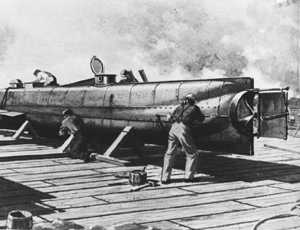
As a result of the American Civil War, armored ships, steam power plants, mines, spar torpedoes, explosive shells, and various other technological innovations, including the submarine, had been introduced as radical new concepts in conducting naval warfare. The Confederate submersible, CSS Hunley, was the first submarine built for deep submergence, and she was powered by eight men working in a hand-cranked propeller.
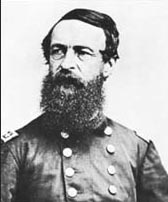
David Dixon Porter (1813-1891) and other Navy visionaries were concerned about the impact that emerging technologies would have on future naval warfare. In 1869, when Admiral Porter became the assistant to the Secretary of the Navy, he actively campaigned for the creation of an experimental station to conduct hands-on experiments with torpedoes, mines, explosives and electrical devices to determine how these new technologies should be employed.
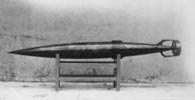
The Fish torpedo (left), the Navy’s first self-propelled torpedo, was built by the Naval Torpedo Station in 1871. The design was based on the physical characteristics of the Whitehead torpedo designed by the Englishman Robert Whitehead in Fuime, Austria.
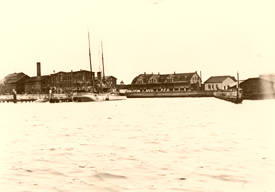
The Naval Torpedo Station as it appeared in 1880 on Goat Island in Newport (right). The amount of torpedo hardware being generated was rapidly increasing, and during the first three decades of existence, the torpedo station found itself in a race to build new physical facilities fast enough to keep up the expanding torpedo program requirements.
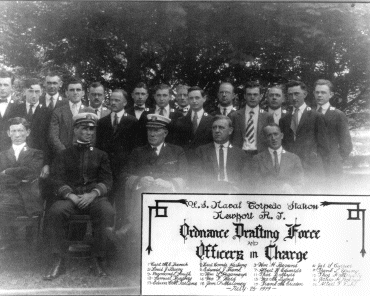
Up through the mid-1880s, the commanding officers at the Naval Torpedo Station were hand-picked by Admiral Porter, most of them having served with him during the Civil War. An impressive number of these early officers achieved flag rank later in their careers, including Admiral Dewey, the hero of Manila Bay; Admiral Sampson, who defeated the Spanish at Havana; and Admiral Fletcher, who received the Congressional Medal of Honor for commanding naval forces at Vera Cruz in 1914. They and many others will long be remembered for their pioneering efforts in establishing the world’s first torpedo activity.
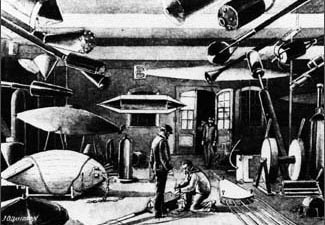
Storage room for torpedoes at the Naval Torpedo Station (right). The torpedo station issued weapons to the fleet as they were needed.
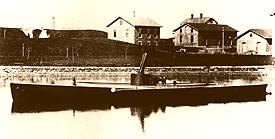
The Herreshoff spar torpedo boat Lightning docked at the Naval Torpedo Station (left).
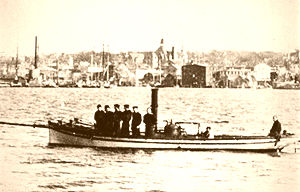
The spar torpedo, used with some success during the Civil War, consisted of an explosive charge fastened to the end of a spar secured to a boat (right). Rigged this way, the spar torpedo could be projected forward or abeam and lowered well below the waterline of an enemy ship.
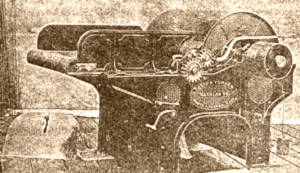
This machine (left) was used to pick apart raw English cotton, the first step in producing guncotton (used prior to 1900). The Naval Torpedo Station was the first major contributor in the development and production of new high-energy explosives for the U.S. Navy. The results obtained with nitroglycerin and dynamite were spectacular, but because of the shock sensitivity and instability of these compounds, guncotton appeared to be a wiser choice for volume production and fleet use.
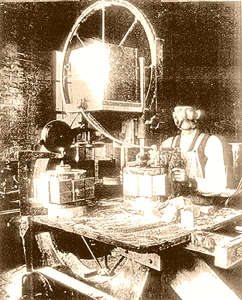
Reducing the cotton to a pulp and solidifying it was the third process in guncotton production. This band saw (right), a very dangerous tool, was used to create the warheads. The second step to processing guncotton, the nitration process, was known as the nitrate bath. The cotton (nitrate/cellulose) was washed and carried to the next building for the final step in the process.
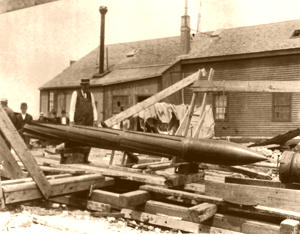
The Cunningham rocket torpedo (left), designed by a New Bedford shoemaker (circa 1893), was tested for several years at the Naval Torpedo Station. Lack of accuracy and wide variations in speed were major problems which kept early rocket torpedoes in the experimental stages.
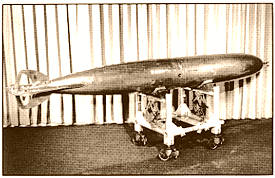
The Howell torpedo (right) was the first automobile torpedo issued to the fleet. It had a range of 400 yards at a speed of 25 knots and a maximum range of 700 yards. The warhead charge was 100 pounds of guncotton. Just prior to launching, a 130-pound flywheel in the torpedo was spun to 10,000 rpm by a slip-mounted steam engine.
In the mid-1880s, the Navy initiated the design and procurement of a new class of steel-hulled fleet torpedo boats to employ the new Howell torpedo. Herreshoff Manufacturing Co. in Bristol, R.I., was selected to build the first of these sea-going vessels.
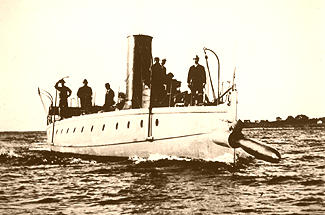
The USS Stiletto (left) was the first Cushing-class torpedo boat purchased by Naval Torpedo Station. The new torpedo boats were named the Cushing class in honor of the Civil War hero Lt. William B. Cushing, who sank the Confederate iron-clad warship Albemarle with a spar torpedo.
Click here to read NUWC's history from 1900 to present.